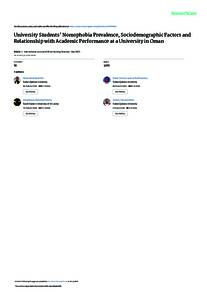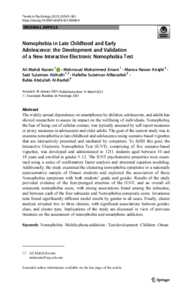Document
University students’ nomophobia prevalence, sociodemographic factors and relationship with academic performance at a University in Oman.
Identifier
DOI: 10.1016/j.ijans.2020.100206
Source
International Journal of Africa Nursing Sciences. v. 13, 100206
Contributors
Country
Netherlands.
Publisher
Elsevier Ltd.
Gregorian
2020-01-01
Language
English
English abstract
Background: Nomophobia “no mobile phone” and phobia” is a pathological fear of being out of contact with a mobile phone, has no mobile networks, or has insufficient balance or battery. Purpose of the study: To determine the prevalence of nomophobia, demographic factors affecting nomophobic behaviors, and the relationship between nomophobia and academic performance among university students in Oman. Methods: A descriptive correlational study design was chosen to describe the prevalence of nomophobia among Sultan Qaboos University students. A convenience sampling technique was used to select 735 students based on defined inclusion criteria. Nomophobia was identified using a self-report instrument, the Nomophobia Questionnaire, which includes 20 Likert scale items rated from 1 (“strongly disagree”) to 7 (“strongly agree”). Descriptive analysis and a Pearson correlation statistical test were used to determine the possible relationship between nomophobia and academic performance. Results: The prevalence of nomophobia among students was 99.33%, most with a moderate level of nomophobia. Students with severe nomophobia reported weak academic performance (p = .706), but this was not statistically significant. Conclusion: This study found a high prevalence of nomophobia and a weak relationship with academic performance. More studies should be conducted in this area to inform policy on cellphones within academic premises, to avoid serious ill effects of chronic use.
ISSN
2214-1391
Category
Journal articles


